Brambles: Organic Production
By George L. Kuepper, Holly Born, and Janet Bachmann, NCAT Agriculture Specialists; Updated by Luke Freeman, NCAT Agriculture Specialist
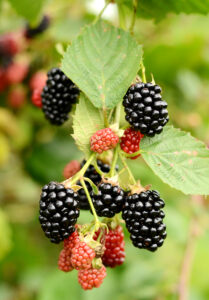
Blackberries make a great addition to a diversified market farm or can be the main focus of a berry farm. Photo: Luke Freeman, University of Arkansas
Abstract
This publication focuses on organic practices for blackberry and raspberry production. It discusses cultural considerations including site selection, establishment, pruning and trellising, and it introduces organic practices for fertility, weed, disease, and insect management. It also provides new information on greenhouse production and season extension and addresses economics and marketing.
Introduction
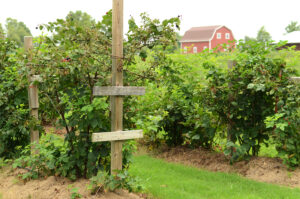
Sta-n-Step Blueberry Farm in Fayetteville, Arkansas, grows u-pick blackberries, raspberries, and blueberries. Photo: Luke Freeman, NCAT
Bramble fruits are a versatile and profitable crop that can fit into a diversified farming operation or be the primary focus of a berry farm. This publication provides an overview of the basics of blackberry and raspberry production with a deeper focus on management considerations and practices that are specific to organic growers. For more in-depth information on varietal selection, pruning, trellising, and irrigation, consult the resources at the end of this publication. Contact your local Cooperative Extension Service for information specific to your region. If you have not already done so, we encourage you to read ATTRA’s Tree Fruits: Organic Production Overview, which provides valuable introductory information on organic fruit culture.
Organic growers use a combination of cultural practices, natural materials, and biological controls to maintain plant health and soil fertility. Bramble fruits are well-suited for organic production because of the limited number of insect pests and diseases they experience, although that has changed somewhat with the newly introduced insect pest, the spotted wing drosophila.
Although anyone can choose to grow organically, federal regulations control the labeling and marketing of all organic products. If you grow on a commercial scale and plan to market your produce as organic, you will need to be certified.
Cultural Considerations
The Basics of Bramble Production
Blackberries and raspberries are considered bramble fruits, as are the less common dewberry, tayberry, boysenberry, and loganberry. Bramble fruits fall within the genus Rubus, which shares the family Rosacea with common fruits including apple, peach, pear, and strawberry. Modern breeding efforts have significantly improved domesticated blackberry and raspberry cultivars. Traditionally, bramble fruits have been thorny like their wild ancestors, but there are many thornless blackberry and raspberry cultivars now available for commercial production. Another advance has been the development of primocane-fruiting cultivars, first developed in raspberries and now present in blackberry cultivars, as well.
Typically, bramble canes are vegetative during their first year of growth, when they are called primocanes, and they bear fruit during their second year, when they are called floricanes. Traditional floricane-fruiting brambles will flower in the spring and bear fruit in early summer on floricanes only. Primocane-fruiting cultivars, however, have the ability to bear fruit in the fall on primocanes that emerged that spring. These canes can then fruit again the following season, during the time when floricanes would typically bear fruit. Primocane-fruiting raspberries are sometimes referred to as everbearing raspberries because of their ability to continue to bear fruit on primocanes from summer until first frost.
By taking advantage of the various seasons of production for different blackberry and raspberry cultivars, it is possible to harvest berries on your farm beginning in late spring and ending in late fall, assuming you have the right environmental conditions. Because growth and fruiting habits vary greatly among bramble species and cultivars, it is important to know the specific cultural guidelines for the cultivars you are growing. Consult the resources listed at the end of the publication for more cultivar-specific information.
Bramble plantings can be established from bare-root dormant suckers, tip-layered canes, tissue-cultured plants, or root cuttings, though dormant suckers and plants are the most commonly used planting stock in the eastern United States (Bushway et al., 2008). Obtaining high-quality virus-free planting stock is vital for successful organic production, and the added plant expense is well worth the investment.
A bramble planting is typically managed as a hedgerow, with plant spacing and selective cane removal used to maintain a specific cane density, depending on the species and trellising system. The row spacing for commercial plantings varies from nine to12 feet with a closer spacing leading to higher yields per acre, and a wider spacing allowing for tractor operations and mechanical harvest (Bushway et al., 2008; Morrison et al., 1993). Despite the fact that brambles are fairly drought-tolerant, drip irrigation systems are recommended for all commercial plantings to ensure optimal plant performance and consistent fruit quality.
Site Selection and Preparation
Planting-site considerations depend on your growing region. In the eastern United States, the planting site should be higher than the surrounding area to allow for air and water drainage, moving humid air and excess moisture away from the planting. This will reduce disease pressure and decrease the likelihood of winter injury and spring frost damage. Although air movement is generally a good thing, exposed sites that are subject to strong winds can lead to desiccation and winter-kill of bramble canes, so wind breaks may be needed.
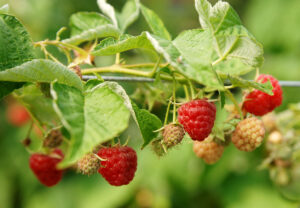
Josephine raspberries at the University of Arkansas research farm. Photo: Luke Freeman, University of Arkansas
In the western United States, elevated sites pose a greater risk in exposing brambles to excessive winds and potential snow damage. In coastal California, it is common practice to grow brambles in high tunnels to protect the plants from wind and sun damage.
Brambles are adapted to a wide range of soils but do best when planted on well-drained, deep, fertile soil that is high in humus and free of hardpan. They prefer a pH of 6.0 to 6.5. Compared to raspberries, blackberries are more tolerant of heavy soils and the soil-borne diseases often associated with heavy soils. However, be sure to allow for adequate drainage in heavy soils by taking steps such as adding organic matter and planting in raised beds.
Sites previously planted to fruit crops (e.g., peaches, apples, grapes, brambles, etc.) are poor choices because of potential problems with crown-gall infection. Likewise, land recently planted to solanaceous crops (e.g., tomatoes, potatoes, peppers, eggplant, tobacco) presents increased risks of Verticillium wilt. Nearby thickets of wild brambles should also be removed, if possible, to reduce sources of insect pests, diseases, and insect-vectored viruses. Experts advise 300 to 600 feet of separation from wild hosts or other commercial plantings (Bushway et al., 2008; Poling, 1992).
Perennial weeds, especially aggressive grasses such as Bermudagrass and Johnsongrass, should be controlled in advance of planting. This is extremely important in organic and reduced-herbicide plantings, as perennial weed pressure can significantly reduce yields. Multiple seasons of cover cropping combined with timely cultivation can be an effective organic means of eliminating perennial weeds from a site prior to planting (Kuepper, 2015).
Species and Cultivar Selection
Cultivar selection is a very important decision for a bramble grower because it can determine the productivity and profitability of an operation. The best place to start is by talking with bramble growers in your area to see what cultivars have performed well for them. Your Cooperative Extension Service will also be able to recommend proven cultivars for your region and provide resources with additional cultivar information. Selecting cultivars with resistance to diseases that are prevalent in your region, such as Phytophthora root rot, is extremely important, especially for organic growers, who have fewer options when it comes to disease management.
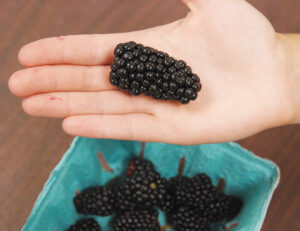
Natchez blackberry can produce very large fruit, which can be a marketing advantage. Photo: Luke Freeman, University of Arkansas
Two important considerations when selecting cultivars include your market and desired season of production. Knowing the preference of your target customers and the market price of various bramble species will help you narrow down to the cultivars that are best suited to your situation. If you are selling direct-to-consumer, taste might be the most important characteristic, but if you are selling wholesale to a retailer or distributor, then shelf life or post-harvest potential might be the most important attribute for the cultivars you select.
Seasonality is also very important. With primocane-fruiting blackberries and raspberries and season extension technologies, it is possible to produce a berry crop nearly year-round in certain areas. Knowing when you want to be selling your crop and the seasonality of your target markets will also help you narrow in on the right cultivars.
When purchasing your plants, it is very important to buy from a reputable supplier to ensure quality planting stock that is disease- and virus-free. There are few restrictions on proximity when planting different varieties and species of brambles on the same farm. One is that black and purple raspberries are much more susceptible to damage from mosaic and leaf curl viruses than are red and yellow cultivars. Because these diseases are vectored by aphids, black and purple varieties should be separated as much as possible and located upwind from red and yellow raspberries (Funt et al., 1999).
Alleyway Management
The alleyways in a bramble planting can be managed with either clean cultivation or perennial groundcover, though the practice of clean cultivation is discouraged. Clean cultivation is costly, leads to the destruction of soil structure, and increases the risk of soil erosion (Bowen and Freyman, 1995). A perennial groundcover, on the other hand, offers protection against soil erosion and the loss of nutrients through leaching, while also suppressing weeds. Groundcovers can be established prior to planting the bramble crop or during the fall season of the planting year. These groundcover plantings may compete with the bramble crop for nutrients and moisture, however, which is why a 4-foot-wide vegetation-free strip should be maintained around the berry row (Poling, 1992).

Stay-n-Step Blueberry Farm manages their sodded alleyways by mowing. Photo: Luke Freeman, NCAT
The selection of plant species for use in sodded alleyways is important. Non-aggressive sod-forming grasses like bluegrass, fescue, and perennial ryegrass (Lolium perenne) are recommended (Pritts and Handley, 1989), as they are only moderately competitive with brambles. Aggressive species like Bermudagrass should not be used. Legume species such as clovers can also be used as groundcovers and are advantageous because of biological nitrogen fixation.
Legume ground covers can be grown on their own or as a companion to grass species in sodded alleyways. Because they fix nitrogen, legumes will not compete with the bramble crop for soil nitrogen and can potentially contribute nitrogen that becomes available to the bramble crop after the legume ground cover is mowed.
In a Canadian study, raspberries grown with white clover as a ground cover showed higher yields, increased vegetative growth, and increased nitrogen uptake compared to raspberries grown with a perennial ryegrass groundcover. When compared to clean cultivation, yields with the white clover cover crop were comparable, demonstrating that the ryegrass groundcover actually suppressed yield by limiting the nitrogen availability to the raspberry crop (Bowen and Freyman, 1995).
The downside of legume ground covers is the fact that they can harbor stinkbug and tarnished plant bug populations. In Oklahoma, at the Kerr Center for Sustainable Agriculture, a blend of subterranean, Dutch white, and ladino clovers was successfully used in alleyways in a blackberry planting. Frequent mowing appeared to reduce the threat from stinkbugs and plant bugs and prevented weed-seed development.
For additional details on cover crops, see ATTRA’s Overview of Cover Crops and Green Manures.
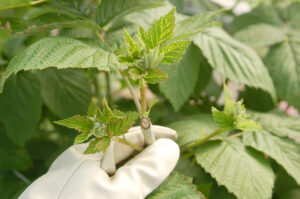
Tipping this raspberry cane has induced later branching. Photo: Luke Freeman, University of Arkansas
Pruning and Trellising
Appropriate pruning and trellising methods are critical for a productive and healthy bramble planting. Timely pruning and tipping will increase the fruiting potential of the bramble canes, in addition to opening up the canopy to allow for good air circulation and sun exposure. A good trellis system will support canes, keep fruit off the ground, improve sunlight exposure, increase air flow, increase spray penetration into the canopy, and allow for ease of harvest.
Pruning management will depend on the species and cultivar being grown, in addition to your production region. More detailed information can be found though your Cooperative Extension Service and in the resources listed at the end of this publication. To provide a brief overview of bramble pruning, there are a few concepts that are important to understand for any bramble crop being grown.
Tipping
Tipping is the process of removing the tip of the cane to halt its vertical growth and encourage lateral branching. For both floricane- and primocane-fruiting blackberries, tipping is required when the primocanes are three to five feet tall, depending on the cultivar (Fernandez et al., 2016). Soft-tipping is recommended, which refers to pinching off one to four inches of the tender shoot by hand. This leaves a smaller wound on the cane and helps reduce infection by cane blight (Brannen and Krewer, no date) compared to hard tipping, which is conducted when the cane is woody and requires pruning shears.
The lateral branches that grow out from the primocane after the initial tipping may also need to be tipped. Depending on the cultivar, these laterals will need to be tipped or pruned to a final length of 10 to18 inches to maintain a compact canopy.
Thinning and Cane Removal
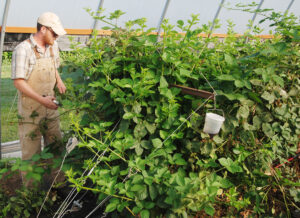
Spent floricanes are being pruned out of the high tunnel blackberry planting at the University of Arkansas research farm. Photo: Luke Freeman, University of Arkansas
Canes will need to be thinned out of the hedgerow to maintain the proper cane density. The appropriate cane density is cultivar-dependent, but typically ranges from two to six canes per foot (Fernandez et al., 2016; Bushway et al., 2008). This thinning can be conducted in the spring, as the primocanes are growing, or in the late winter for floricane-fruiting types.
Spent floricanes will need to be removed after fruit is harvested, because these canes will no longer be productive. These canes can be removed selectively in the late summer or fall, after harvest. In colder climates, it can be beneficial to wait until late winter before removing these canes, because they will contribute carbohydrate stores to the crown to help it survive the winter (Fernandez et al., 2016). Destruction of spent floricanes is important for disease and insect pest control. Removing and burning these floricanes is commonly recommended, though shredding and soil incorporation are sometimes practiced.
Mowing
Mowing can be used in larger-scale plantings to reduce the labor costs of pruning. Primocane-fruiting cultivars that are managed for a single fall crop can be mowed in late winter or early spring, before new growth occurs. Because primocane-fruiting cultivars bear fruit on one-year-old canes, this still allows for an annual harvest.
For floricane-fruiting cultivars, alternate-year mowing can be practiced to eliminate the need to remove spent floricanes selectively from the hedgerow. In this practice, 50% of the planting is mowed down during the dormant season. Because it takes two years for floricane-fruiting cultivars to bear fruit, only half of the planting will be harvested each year. Due to the limited competition from primocanes, yield is only reduced by 30%, while spray costs are reduced by approximately 50% (Bushway et al., 2008).

A wooden T-trellis with two sets of wires to support blackberry canes. Photo: Luke Freeman, NCAT
Trellising
Although some cultivars are upright in growth habit and can be grown without a trellis system, most bramble fruits benefit from the additional support. The goal of a trellis system is to keep fruit off the ground, allow for good light penetration and air circulation throughout the canopy, and assist in ease of harvest. These factors will contribute to a healthier bramble planting with higher productivity and more efficient harvest. For organic growers, ensuring good canopy management is key to reducing disease and pest incidence. And because trellising allows for easier access to fruit, cleaner picking is possible, resulting in fewer overripe berries—which also lessens the attraction to picnic, sap, June, and Japanese beetles (Fernandez et al., 2016).
When selecting a trellis system, important considerations include cost of materials and construction, availability of labor, and regional climate. Treated lumber is not allowed in organic production and alternatives to treated-wood posts must be found. More information appears in the ATTRA publication Pressure-Treated Wood: Organic and Natural Alternatives. Researchers at North Carolina State University have estimated the cost per acre of various bramble trellis systems (Safley and Fernandez, 2011). With their cost assumptions, a V-trellis with metal posts costs $3,960 per acre, a T-trellis with wooden posts comes to $4,623 per acre, and the Shift Trellis comes in at $5,740 per acre.
The most common trellis systems for bramble fruits include the V-trellis and T-trellis, which both provide two sets of wires at two heights to support the canes and allow for an open canopy in the middle of the row. Materials used for these systems usually include wooden posts, steel posts, and wire, with metal or wooden cross-arms being an additional component of the T-trellis (Fernandez et al., 2016). Detailed information on trellis systems can be found in the resources listed at the end of this publication.
The Shift Trellis and Rotating-Cross-Arm Trellis are new trellis systems that have been designed for floricane-fruiting blackberries to increase productivity and ease of harvest, and allow for protection from winter injury in northern climates. The trellis arms pivot on an axis that allows for cane manipulation to induce fruit formation on one side of the trellis arm, which permits fruit to ripen in the shade. These systems are costly to install and require additional labor for management, but the current results appear promising (Takeda et al., 2013).
Greenhouse and High Tunnel Production
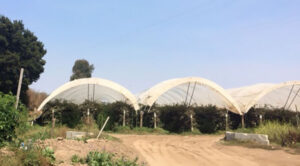
Multi-bay high tunnels are commonly used for bramble production in California. Photo: Thea Rittenhouse, NCAT
Greenhouses and high tunnels create controlled environments that can dramatically improve yield and fruit quality for both raspberries and blackberries, while also assisting in pest management. Returns can be higher in these controlled-environment systems compared to the field, but growers should do careful research and planning before investing in any of these systems. More information on greenhouse and high tunnel berry production can be found in the resources listed below.
Greenhouse Raspberry Production
Research has been conducted at Cornell University to develop greenhouse production systems that provide raspberries year-round for the local fresh market. Researchers at Cornell have found that greenhouse-grown raspberries are larger, firmer, and less prone to fruit rot compared to field-grown raspberries, and that consumers are willing to pay premium prices for off-season local raspberries.
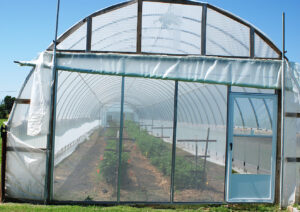
Primocane-fruiting blackberries and raspberries within a high tunnel at the University of Arkansas research farm. Photo: Luke Freeman, University of Arkansas
This production system involves growing raspberry plants in containers in the greenhouse. Plants are started in soil-less media in pots outside in the spring and then brought into the greenhouse in early winter, after they have met their chilling requirement. Once in the greenhouse, canes are trellised and fertilized. Temperatures are maintained at 65°F during the day and 50°F at night. This controlled temperature regimen and supplemental lighting causes the raspberries to flower after six weeks, which can lead to production as early as mid-February.
In this system, each plant produces about two half-pints (350 g) of fruit in the first year and 16 half-pints in subsequent years. When fruit is sold at $3.00 per half-pint, this can lead to net profits of $4,786 after four years of production in a 24-foot by 96-foot unlighted greenhouse (or roughly $2,000 per 1,000 square feet).
More information about greenhouse raspberry production can be found in the Cornell publication Greenhouse Raspberry Production Guide, by Kurk Koester and Marvin Pritts.
High Tunnel Production
High tunnels are relatively inexpensive compared to greenhouses and can be a very cost-effective means of maximizing the production and quality of bramble crops. Multi-bay high tunnels are very common for raspberry production in California, with more than 4,000 acres under plastic in 2007, according to USDA statistics (2008), and an estimated 100 acres of high tunnel blackberries and blueberries in Oregon (Demchak, 2009). For diversified and small-scale growers, or growers in areas with high winds, single-bay high tunnels are much more common, with brambles grown in-ground and trellised as they would be in the field.

Lady beetles are released inside a screened high tunnel to provide biological control of aphids on blackberries and raspberries. Photo: Luke Freeman, University of Arkansas
Research at The Pennsylvania State University showed primocane-fruiting red raspberry cultivars producing two to three times as much marketable fruit in a high tunnel compared with a previous field study (Demchak, 2009). That research also resulted in a 50% longer season in the high tunnel compared to the field, with three to four weeks of earlier production in the spring and three to four weeks of extended production in the fall. High tunnels at Penn State also improved the survival of blackberry cultivars that would otherwise suffer winter injury in the Northeast.
Although raspberry production in the south is marginal due to high summer temperatures, blackberries can be grown very successfully with additional benefits from high tunnel production. Research at the University of Arkansas resulted in earlier production of ‘Natchez’ blackberry by one to two weeks, increased production by as much as 200%, and increased berry size by 30% compared to field production (Rom, 2015). Increases in yield of the primocane-fruiting blackberry Prime-Ark 45 ranged from 50% to 300% in the high tunnel compared to the field, with harvests extending until December in two out of three years of the study (Rom, 2015). Much of the increase in yield was attributed to protection from environmental stresses, such as summer rains, which decrease quality and marketability of field-grown blackberries.
High Tunnel Bramble Production Resources
- High Tunnel Production Guide for Raspberries & Blackberries. 2012. By Cathy Heidenreich, Marvin Pritts, Kathy Demchak, Eric Hanson, Courtney Weber, and Mary Jo Kelly. Department of Horticulture, Cornell University.
- High Tunnel Brambles. 2014. By Cheryl Kaiser and Matt Ernst. University of Kentucky Cooperative Extension Service.
- Fruit Research Station. University of Arkansas System Division of Agriculture.
Insect pests common to greenhouse production can become an issue in high tunnels, with two-spotted spider mites, whitefly, aphids, and thrips showing higher populations in high tunnel systems compared to field production. Releases of lady beetle larvae and adults can be an effective means of biological control of aphids in a screened high tunnel system where lady beetles can’t escape. Lacewings can also provide effective control of aphids (Heidenreich et al., 2012).
Researchers at the University of Kentucky estimate break-even prices for high tunnel blackberries to be $3 to $5 per pound and $4 to $6 per pound for raspberries sold over seven years (Kaiser and Ernst, 2014). This break-even analysis covers the cost of the high tunnel, estimated at $1.30 to $1.50 per square foot, in addition to fixed and variable costs of production.
Weed Management
Aspects of weed management already discussed include suppression via cover crops and the importance of pre-plant weed control. Refer to ATTRA’s Tree Fruits: Organic Production Overview for details on pre-plant weed-control strategies. Subsequent weed control in established bramble plantings through cultivation, hoeing, or hand-weeding is very difficult. Traditional grape hoes or modern tractor-mounted cultivators such as the Weed Badger™ and Green Hoe™ can be used for mechanical weed control. Whatever the technology employed, all mechanical weeding must be shallow to avoid root damage.
Mulching
Research over the years has demonstrated definite advantages to mulching in raspberries (Pritts, 1991) and thornless blackberries (Funt et al., 1994; Rom and McAfee, 2004). Mulching conserves moisture, moderates temperature fluctuations, decreases weed pressure, and enhances yield. Organic mulches such as wood chips and straw will also contribute to soil organic matter through their decomposition. Results of research at the Missouri Fruit Experiment Station, however, show that while mulching with organic materials can be helpful in controlling some weeds, it is not sufficient for total weed control by itself. In fact, excessively deep in-row mulching can interfere with primocane emergence and may also harbor damaging rodents.
Mulching can also aggravate Phytophthora root rot problems on susceptible red raspberry cultivars grown on heavy (clayey), irrigated soils. In such a situation, New York researchers recommend straw mulch during the establishment year only (Wilcox and Pritts, 1993). In the Southeast, however, hardwood or pinebark mulch is commonly used in blackberry plantings for weed management and soil moisture conservation (Krewer et al., 2001).
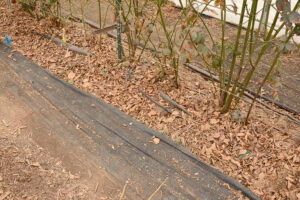
A heavy-duty weed-barrier fabric is used on either side of a high tunnel blackberry planting to suppress weeds. Note how the row center is left open to allow for fertilization. Photo: Luke Freeman, University of Arkansas
Black plastic mulch can also be used for weed control in the establishment year. Beds can be shaped and mulch applied using a bed-shaper and mulch-layer, with drip irrigation placed under the mulch. Brambles can be planted into the plastic by tearing a small hole where the plant needs to be inserted. The plastic mulch will need to be removed or slit down the middle to allow for primocane emergence the following year, but the weed suppression during the establishment season can make the practice worthwhile. USDA National Organic Program rules require the removal of plastic mulch at the end of the season (NOP §205.206); however, some certifiers make an exception for perennial crops where plastic mulch can be left for more than one season but must be removed before it begins to decompose or break down. Check with your certifier before using plastic mulch, to ensure that they approve of the practice.
Geotextile mulches, such as woven plastic and weed-barrier fabrics, are gaining favor as long-term weed control solutions due to their extended life. These can be used in bramble plantings, although they are subject to the same NOP rules as plastic mulch. Because these fabrics are thick, they can prevent primocanes from emerging within the planted row if an opening is not provided. Plantings have been made using the fabric solely as an in-row cover, and also as a seamless mulch sheet, extending row-to-row across the middles. Though the initial cost is high, it may prove reasonable when amortized over the expected lifetime of five to 10 years, especially when labor savings are taken into account. Available fabric mulches include Sunbelt™ by DeWitt Co. and Lumite by Shaw Fabrics, which are available through most farm and garden supply companies. The heavy-grade options are recommended because they will have a longer life span.
Fertility Management
Sustainable fertility management in brambles begins well in advance of planting, with soil testing and site preparation. Refer to ATTRA’s Tree Fruits: Organic Production Overview, for general information on pre-plant soil preparation for fruit crops, plus additional information on fertilization. Some specific aspects of site preparation for bramble crops are noted below.

Use a soil probe or shovel to collect multiple 6-inch soil cores from your field for testing. Photo: Luke Freeman, University of Arkansas
Soil Testing
Sample and test your soil prior to planting to determine your site’s soil pH and nutrient levels, and make adjustments during the site-preparation phase. It is much easier to make adjustments to your soil before plants are in the ground. After planting, biannual soils tests and annual plant-tissue testing is advised to identify nutrient imbalances and allow growers to adjust fertilization accordingly. Testing services are available through county and state Cooperative Extension.
Soil pH
The ideal soil pH for bramble fruits is 6.0 to 6.5. A soil pH outside of this range will make necessary plant nutrients less available to the bramble crop. The soil pH should be adjusted prior to plant establishment, using materials that are compliant with organic certification.
Soil Nutrients
Nitrogen (N)
Annual applications of supplementary fertilizer—especially nitrogen—are needed in most bramble plantings to sustain good yields, even when cover crops and mulches are used. Organic growers primarily use manures, composts, animal by-products, and vegetable or seed meals to make up the difference. Estimates of total nitrogen fertilizer requirements are provided below. Any nitrogen fertilizer application should be based on soil test results and take into account nitrogen applied through cover crops, manure, or compost. More information on the use of manure and compost is provided in the corresponding sections below.
During the establishment year, fertilizer application should be delayed until four weeks after planting, especially if salt-based materials or manures are applied, because young brambles are easily salt-damaged. Maintenance rates shown in Table 1 can be applied as a single spring application at bud break, or split to apply half then and the remaining half three to four weeks after bud break. Split applications are most effective in light or sandy soils with low organic matter content (Pritts et al., no date).
Phosphate (P)
Avoid excessive applications of phosphate. High levels of soil phosphorus have been associated with zinc deficiency in brambles. Growers planning to use poultry litter prior to establishment, or as a maintenance fertilizer, should be sure to take note and monitor soil phosphorus levels regularly, because poultry litter is high in phosphates.
Conversely, if phosphorus is needed, bone meal and fish meal are good organic sources. Some fish-meal products may include synthetic additives, so be sure to check the OMRI list (www.omri.org) or contact your certifier to ensure that the product you are using is allowed in organic production. Rock phosphate can also be used, though it has a very slow rate of P release.
Potassium (K)
Berry crops have a fairly high demand for potassium, so soil K should be monitored with testing on a biannual basis. If K is needed, sul-po-mag and potassium sulfate are good organic sources. Wood ash can also be used, but it is very alkaline and can raise soil pH above the desired range.
Brambles are sensitive to chlorine salts, so potassium chloride should be used sparingly or not at all.
Magnesium and Boron
Magnesium and boron deficiencies sometimes occur in brambles, though these are less likely under a sound organic fertilization scheme. Magnesium deficiencies can occur under conditions where excessively high potassium levels are accompanied by low calcium. Dolomitic limestone, sul-po-mag, and Epsom salts are suitable for correcting soil deficiencies. Boron deficiencies are most likely in high pH soils, particularly in the Northwest. Small amounts of Solubor™ or borax are commonly used as amendments (Anon, 1991; Scheer, 1992). It is important to note that, under organic regulations, nutrient deficiencies must be documented before any of these supplemental fertilizers can be applied.
Organic Fertilizers
When using organic fertilizers—especially unprocessed manures—growers may find that any material not finely textured is difficult to spread by hand within an established bramble hedge-row. Large clumps of organic matter can also impede primocane emergence. Coarse-textured compost or manure is more easily applied if screened or simply broken up with spading forks or shovels.
In contrast to animal manures, commercial organic fertilizers are more predictable as to nutrient content, and their texture makes it easy to apply them to brambles. Cottonseed meal (N-P-K approximately 5-2-1) is a good organic fertilizer for brambles, though the grower needs to ensure that the source is non-GMO if it is being used in organic production. Feather meal (13% N) and blood meal (12% N) are good sources of nitrogen, with blood meal providing more readily-available N for plant uptake. Other blended organic fertilizers can be found to fit your fertility needs.
If using landscape fabric or plastic mulch for weed control, consider how this barrier will affect your fertilization strategy. Some landscape fabric materials are permeable and can allow soluble fertilizers to pass through, but plastic mulch and many other weed barriers are not permeable. In the case of non-permeable mulches, liquid fertilizers will need to be injected through the drip line underneath the mulch, or the material will need to be slit or removed to allow for granular fertilizers to be applied in bands. Liquid fish hydrolysate is an organic fertilizer that can be injected through a drip irrigation line, though care must be taken to ensure that the material does not clog drip emitters.
Cover Crops
If a green-manure cover crop is grown before bramble establishment, be sure to credit the nitrogen contribution and reduce supplementary fertilizer rates accordingly. Winter legumes can produce a significant amount of nitrogen that will become available after the cover crops are incorporated in the spring. For example, hairy vetch can produce more than 100 pounds per acre of N, and crimson clover can produce as much as 150 pounds per acre of N (Clark, 2012). ATTRA’s Overview of Cover Crops and Green Manures provides information useful in making cover crop decisions and estimating N contribution. After bramble establishment, you cannot count on alleyway cover crops to contribute significant amounts of N for the bramble crop, so it would be best to choose a grass-species cover crop like fescue that would provide erosion protection and be easy to mow.

Compost can be used to increase soil organic matter, improve soil quality, and provide some plant-available nutrients. Photo: Luke Freeman, Kerr Center for Sustainable Agriculture
Manure and Compost
It is a good rule of thumb to assume that only 50% of the nitrogen in most manure or compost will be available during the year of application. (The availability of nitrogen in fresh poultry manure may be closer to 90% in the first year.) However, the remaining nitrogen will become available in subsequent years and should be credited accordingly.
Be especially cautious to avoid nitrogen over-application and nutrient imbalances when using manure. The fertilizer value of manure is highly variable and usually unbalanced with respect to nitrogen, phosphorus, and potassium (N-P-K). Considering these properties, specific application rates are impossible to recommend. Typically, farmers apply manures at roughly one to four tons per acre, depending on the fertility of the soil. Poultry manures, which are usually higher in nitrogen, are applied at one to two tons per acre.
The timing of manure applications is very important. Manure cannot be applied to the plants within 120 days of harvest under conditions where the fruit is either in contact with the soil or can be splashed with soil from rainfall or irrigation. Manure cannot be applied within 90 days of harvest where the fruit is elevated or otherwise shielded from soil contact.
If manure is fully and properly composted, it can safely be applied at higher rates and at any time during the season.
Diseases
The foundations of organic disease control are sanitation, plant health, and plant resistance. Good sanitation practices include the removal and destruction of infected plants and the cleaning of tools and implements. Plant health is encouraged through adequate soil fertility, ample soil moisture, and good weed management. Lastly, the selection of cultivars that exhibit resistance to specific pathogens is critical to organic disease management.
Several critical bramble diseases are mentioned below, but additional information on diseases of bramble fruits appears in the resources listed at the end of this chapter.

Healthy raspberry roots (right) and roots infected by Phytophthora fragariae var. rubi (left). Photo: André Bolay, St. Fédér. de Recherches Agronomiques de Changins, courtesy of Bugwood.org
Phytophthora Root Rot
Phytophthora root rot is a soil-borne disease most prevalent at poorly drained sites. The disease is caused by fungi in the family Phytophthora, which require saturated soils to reproduce and infect plant roots (Ellis and Nita, no date). Once infection occurs, it is very difficult to control Phytophthora organically. Red and purple raspberries are most susceptible, while black raspberries and blackberries generally show greater resistance (Bushway et al., 2008).
Infected plants will appear stunted, with weak lateral shoots and leaves that yellow prematurely or scorch as if from drought stress. Canes that are severely infected will wilt and die as weather warms (Bushway et al., 2008).
Although cultural methods can be practiced to reduce the incidence of infection, it is very important to select cultivars that exhibit resistance to Phytophthora.
Sites that are slow to drain, or exhibit standing water, should not be planted to brambles without improvements that allow for efficient drainage. Heavy soils can be amended with large amounts of organic matter and worked with a subsoiler to improve drainage, or raised beds can be created to help water drain away from bramble roots.
Soils that are well-drained are less likely to develop Phytophthora problems. In addition, soil naturally suppressive of Phytophthora fungi contains large amounts of organic matter, plentiful calcium, and nitrogen in the ammonium form (which is produced by decaying organic matter) (Cook and Baker, 1983). In addition, Cornell researchers found that amending soil with gypsum (calcium sulfate) reduced the incidence of Phytophthora in red raspberries (Pritts and Maloney, 1998).
Mulching susceptible red raspberry cultivars can foster Phytophthora problems in irrigated plantings on heavy soils. If all factors are present—susceptible cultivars, heavy soils, irrigation—research indicates that mulch is advantageous during the establishment year, but may favor Phytophthora thereafter (Kuepper and Williams, 1989).
Verticillium Wilt
Verticillium wilt is caused by the fungus Verticillium albo-atrum, which infects plant roots and causes wilting and eventual cane death. To avoid Verticillium problems, it is recommended that growers should wait at least three to four years before planting in a field where potatoes, tomatoes, peppers, eggplant, or tobacco have been grown; however, research has shown Verticillium species to be capable of surviving in the soil for more than 14 years in the absence of a host (Jennings, 1988). Also, common weeds such as black nightshade, redroot pigweed, lambsquarter, and horsenettle can harbor Verticillium (Ellis and Wilcox, 1992).
Soil solarization can be an effective means of organic control of Verticillium (Stapleton and DeVay, 1986). Solarization must be conducted on bare soil – which means before planting or after infected plants are removed. More information about solarization can be found online here and in ATTRA’s Tree Fruits: Organic Production Overview.
Among red raspberries, which tend to be more tolerant, the varieties Cuthbert and Syracuse have proven resistant under field conditions (OSU, no date). Black raspberries are generally more susceptible to Verticillium wilt, however (Bushway et al., 2008). Among blackberries, Himalaya and Evergreen are Verticillium resistant (Ellis and Wilcox, 1992).

Crown gall on blackberry. Photo: Mary Ann Hansen, Virginia Polytechnic Institute and State University, courtesy of Bugwood.org
Crown Gall
Crown gall is caused by the bacterium Agrobacterium tumefaciens (formerly A. radiobacter), which usually enters through wounds in the roots or crowns of raspberry and blackberry plants. The disease is best controlled by planting healthy stock on a “clean” site. On a planting site where crown gall has been known to occur, a waiting period of three to five years is advised before replanting. As an alternative, a biological treatment (dip) with a non-pathogenic strain of a closely related bacterium (A. tumefaciens [formerly A. radiobacter] strain K84) can protect the planting stock from crown gall infection (Cook and Baker, 1983). Two commercial formulations of this treatment are available, GALLTROLL-A and GALLEX (AgBioChem, Los Molinos, California). Solarization has also been shown to be effective in suppressing crown gall in sandy soils and potting media (Putnam, no date; Koike and Wilen, 2009).

Raspberry fruit covered with fungal growth of gray mold (Botrytis cinerea) (right). Photo: John Hartman, University of Kentucky, courtesy of Bugwood.org
Gray Mold
Gray mold is a serious disease of bramble fruit, causing damage to ripe fruit while on the plant and in post-harvest storage. This fungal disease is caused by Botrytis cinerea, which will infect open flowers and fruit during the spring when free moisture is present (Koike et al., 2009). Gray mold can be devastating if rainy weather coincides with harvest, when fruits are at their ripest and most susceptible. Raspberries are more susceptible than blackberries. The only organic management of this disease is through cultural practices, as no fungicides are approved for gray mold control in organic production. Biological agents have been found that exhibit activity against B. cinerea (Vos et al., 2015), but no products have been approved yet for use on bramble crops.
The incidence of gray mold can be reduced by avoiding and reducing free moisture on plant leaves and flowers. Good management practices such as proper training, trellising, pruning, fertilization, and weed management will improve air flow through the plant canopy to reduce humidity and allow for faster drying of plant leaves. Also, frequent harvests (at least three times per week) will prevent over-ripe fruit from becoming infected and spreading the pathogen. Growing bramble crops under cover in a high tunnel or similar structure in conjunction with drip irrigation will greatly reduce incidence of gray mold by eliminating rainfall on the plant.
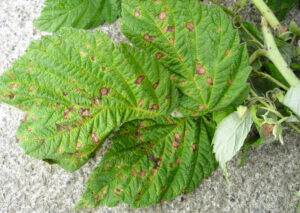
Raspberry leaf spot (Sphaerulina rubi). Photo: Elizabeth Bush, Virginia Polytechnic Institute and State University, courtesy of Bugwood.org
Leaf Spot
Leaf spot is also encouraged by summer rainfall and high humidity. The causal organism for blackberry leaf spot is Mycosphaerella rubi, which is a different species than the causal organism for raspberry leaf spot, Sphaerulina rubi. M. rubi will also infect dewberry and boysenberry. This pathogen will cause small, greenish-black spots to develop on the upper surface of young leaves, which become whitish or gray as the leaf matures. Severe infections will cause cane defoliation (Bushway et al., 2008).
Good cultural practices that improve airflow through the plant canopy and allow for rapid leaf drying will reduce the severity of leaf-spot infections, though in areas with high humidity and frequent summer rains, control can be difficult, especially on raspberry. Dormant sprays of liquid lime-sulfur will reduce the inoculum on over-wintering canes, and copper sulfate can be used after harvest to control the pathogen present on leaves—both of which are treatments approved for organic production. In addition, proper sanitation practices and destroying infected canes will help control the spread of the disease (Koike et al., 2009).
There is some genetic resistance to leaf spot among raspberry varieties. Citadel, Heritage, Southland, Fall Gold, and MN 659 appear especially resistant, and black raspberry varieties demonstrate moderate resistance. Red raspberry varieties Taylor, Sentry, Skeena, Killarney, Brandywine, and Canby appear most susceptible (Wilcox and Pritts, 1988; Bushway et al., 2008).
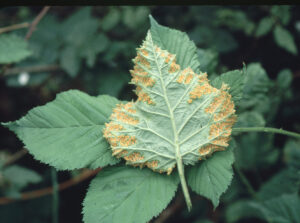
Orange rust (Arthuriomyces peckianus) on blackberry. Photo: Penn State Department of Plant Pathology & Environmental Microbiology Archives, Penn State University, courtesy of Bugwood.org
Orange Rust
Orange rust is a fungal disease that affects blackberries and black raspberries, but not red raspberries. The causal organisms are Gymnoconia nitens and Arthuriomyces peckianus, which cause rust-colored lesions on the underside of leaves, commonly infecting the whole plant and stunting some plants seriously. Control measures include planting clean stock and diligent scouting to rogue out infected crop and wild plants, removing roots and all. Practices to improve air circulation are also advised (Koike et al., 2009; Kleiner, 1993).
Among thorny blackberry cultivars, Chickasaw, Choctaw, Kiowa, Shawnee, Eldorado, Raven, Snyder, and Ebony King appear resistant. Among thornless blackberries, Hull, Chester, and the Arkansas thornless Apache, Arapaho, and Ouachita are also resistant (Bushway et al., 2008; Garcia and Clark, no date).
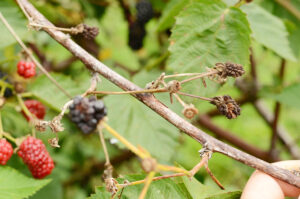
Anthracnose symptoms on blackberry include shriveled fruit and lesions on cane. Photo: Luke Freeman, NCAT
Anthracnose
Anthracnose, Elsinoe veneta, is a fungal disease that can become a serious problem on blackberries and black raspberries and on some susceptible red raspberry cultivars. The disease causes sunken lesions on canes, with infected fruit becoming prematurely shriveled and dry. Sanitation procedures and management practices to improve air circulation play major roles in disease suppression. Additionally, a spray of liquid lime-sulfur applied to canes during the late dormant season is strongly advised for organic production. Under severe conditions, additional later sprays of Bordeaux mixture or a fixed copper may help, though care should be taken not to burn foliage (Brannen and Smith, 2016).
Resistant black raspberries include Blackhawk and Jewel. Blackberries that have moderate to good resistance include thornless Arapaho, Black Satin, Navaho, and Ouachita; and thorny Brison, Brazos, Cherokee, Cheyenne, Chickasaw, Choctaw, Rosborough, Kiowa, Shawnee, and Womack (Bushway et al., 2008; Brannen and Smith, 2016).
Spur Blight
Spur blight is caused by the fungus Didymella applanata, which infects red raspberries and sometimes purple raspberries. The diseases causes brown or purple discoloration on canes, defoliation, and weak cane growth, reducing the yields and life of a planting. Control procedures are essentially the same as those for anthracnose. The cultivars Algonquin, Amity, Festival, Haida, and Prestige all show some resistance (Bushway et al., 2008; Daubeny and Pepin, 1974).
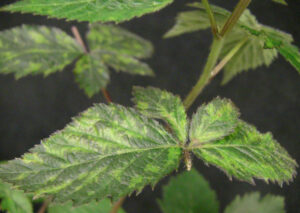
Tobacco Ringspot Virus symptoms on ‘Arapaho’ blackberry. Photo: John Fisher, Ohio Department of Agriculture, courtesy of Bugwood.org
Viruses
There are several bramble viruses of economic importance. Planting virus-free, tissue-culture stock in addition to rogueing out and destroying infected plants are important practices in limiting virus spread. In addition, ensuring the site is free of dagger nematode populations before planting will help prevent infection and the spread of viruses. Raspberries can be particularly hard-hit in areas where aphid vectors of viruses are present. Breeding for resistance to aphid vectors has proven highly effective in restricting virus infection in plantings (Brannen and Smith, 2016; Jennings, 1988; Schaefers, 1988). More information on organic control of aphids can be found below.
Insect Pests
This section provides a brief overview of key pests of bramble crops, including organic management options. For more information on organic pest management, refer to the ATTRA’s Sustainable Pest and Weed Control Database.
Spotted Wing Drosophila
The spotted wing drosophila (SWD), Drosophila suzukii, is a recently introduced pest of small-fruit crops that has had a huge impact on blackberry and raspberry production. It has quickly become the insect pest of greatest concern for organic bramble growers, with few organic materials providing effective control.
Regional Resource Portals for Spotted Wing Drosophila Management
- Northeast
Cornell University, Spotted Wing Drosophila Resource Page- Southeast
NC State University, eFly Spotted Wing Drosophila Working Group- Midwest
Michigan State University IPM, Spotted Wing Drosophila Resource Page- West Coast
Oregon State University, SWD Project Website
The SWD is an invasive vinegar fly that was first detected in the United States in 2008 and is now present from coast to coast. Unlike most vinegar flies, SWD females can lay eggs in undamaged, ripening fruit, resulting in eggs and larvae present in fruit that is sold for the fresh market. Larva can be difficult to detect in ripe fruit without cutting the fruit open, which can easily result in customers being sold infected fruit that will prematurely collapse and not hold shelf life. Although the larva can go unnoticed and are not harmful for human consumption, most customers are very uncomfortable with buying blackberries or raspberries that contain fly larvae.

Spotted wing drosophilia adult. Photo: Hanna Burrack, North Carolina State University, courtesy of bugwood.org
Adult SWD become active in warm summer weather at temperatures above 60°F, which coincides with floricane blackberry and raspberry production in most regions. The fly will continue to reproduce and infect fruit throughout the summer season until cool fall weather, though activity is decreased by high temperatures above 86°F. Raspberries are the fruit crop most susceptible to SWD infestation, with blackberries also preferred by the insect (Caprille et al., 2011). If you are a commercial bramble grower, monitoring for SWD with traps and by scouting the fields regularly is critical. Traps can easily be made from plastic containers, yeast, sugar, and apple cider vinegar (Johnson, 2016; Carroll, 2016). Specific trap recipes can be found through the regional resource portals listed below.

A SWD trap hanging in a blackberry planting. Photo: Luke Freeman, University of Arkansas
Cultural controls are very important for SWD management, though these practices alone will not eliminate the pest. Fallen or over-ripe fruit should be collected and removed on a regular basis to reduce the number of sites for SWD females to lay their eggs. Fruit infested with eggs and larvae can be destroyed by placing it in a sealed clear-plastic bag and leaving it in the sun to solarize. Early and frequent harvest will also help reduce infestation, because the fly is attracted to ripe fruit. Netting can be quite effective in excluding SDW, but the mesh size must be very small (0.98 mm or 18 mesh) to prevent the fly from crawling through. If brambles are being grown in a high tunnel, the netting can be attached to side-wall vents and entrances to prevent the SWD from entering, though care should be taken to allow for adequate air circulation with eave vents, ridge vents, or fans. Also, pollinators will need to be introduced into screened high tunnels to allow for pollination during bloom (Demchak et al., 2013).
There are two organic materials effective against SWD: pyrethrin (e.g., PyGanic) and spinosad (e.g., Entrust). However, the OMRI-listed formulations of these materials are very expensive and will not provide 100% control. In addition, the materials must be applied at least once per week and need to be rotated to prevent resistance from developing in SWD populations (Demchak, 2013; Johnson, 2016).
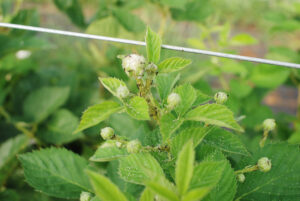
Aphids tend to feed and reproduce near the apical tip of bramble canes and are often associated with ants, which feed on the aphid honeydew. Photo: Luke Freeman, University of Arkansas
Aphids
In addition to vectoring viruses, aphids can cause leaves to become curled and distorted when feeding in high numbers. Aphids tend to feed on new, succulent growth, and high populations can be an indication of excessive nitrogen fertilization. Aphids also tend to be more of a problem in controlled environments such as greenhouses and high tunnels, where rainfall does not wash them off.
There are many natural predators of aphids, such as lady beetles and lacewing larvae, which usually keep aphid populations in check. In controlled environments, these predators can be added to control aphids successfully. In cases of outbreaks, there are several organic insecticides that are effective, including insecticidal soaps, horticultural oils, and neem (Koester and Pritts, 2003).
Mites
Mites are very small arachnids that are barely visible to the naked eye, but they can become a big problem on bramble crops. The twospotted spider mite will infest the underside of bramble leaves and suck juices from the leaf, causing a light gray stippling on the leaf surface. At high enough populations, the spider mites will produce a light webbing that covers the leaf. Spider-mite feeding can cause defoliation, reduced plant vigor, and reduced fruit yield. Because of the hot, dry environment in a high tunnel or greenhouse, spider-mite populations can multiply rapidly, so frequent scouting is required to stay on top of the problem. The predatory mite Phytoseiulus persimilis can be released as a preventative measure in a controlled environment, but if spider mite populations increase, organic materials such as horticultural oil and neem oil can be used (Bolda and Bettiga, 2015).
The redberry mite is a significant blackberry pest in the western United States that causes discolored drupelets. This mite is even smaller than the twospotted spider mite and is best seen with a dissecting microscope. The redberry mite overwinters in buds and then moves into open flowers during bloom, settling among the developing fruit.

Twospotted spider mite adults, juveniles, and eggs seen with magnification. Photo: David Cappaert, courtesy of Bugwood.org
Feeding by the redberry mite causes drupelets to remain hard and have a green or bright red color, resulting in unmarketable fruit and a significant crop loss if left uncontrolled. Organic controls include lime sulfur and horticultural oils, but take care regarding the timing of these sprays (Bolda and Bettiga, 2015). More information on mite management can be found on the UC IPM website.
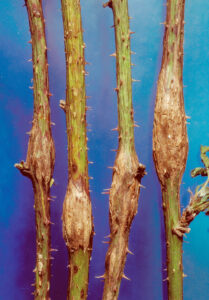
Rednecked cane borer (Agrilus ruficollis) damage on raspberry canes. Photo: James Solomon, USDA Forest Service, courtesy of Bugwood.org
Borers
There are several species of borer that affect blackberries and raspberries, including the raspberry crown borer, the raspberry cane borer, and the red-necked cane borer. Because the larvae spend most of their life cycle inside the cane or crown of the plant, it is difficult to identify infected canes until they begin to wilt or die. Cane swelling can usually indicate the presence of a borer, at which point the infected cane should be removed and destroyed. Because of the limited time that adults fly before laying eggs, it is difficult to control these pests preventatively. More information on the life cycle of borers can be found in the NRAES publication Raspberry & Blackberry Production Guide (listed in the Further Resources section).
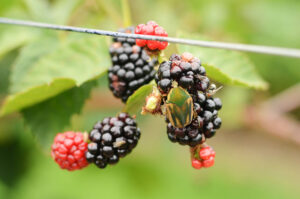
June beetle feeding on blackberries. Photo: Luke Freeman, University of Arkansas
Beetles
Japanese and June beetles can be major pests of bramble fruit if their adult emergence coincides with the ripening of the berry crop. Large populations of Japanese beetles can also result in severe defoliation. Because ripe berries are picked every day or every other day, there are few pesticides that are both effective against these beetles and usable up to the day of harvest. Although there are pyrethrin and neem products that can be used on the day of harvest, their efficacy is not verified, and their expense may be prohibitive.
Consequently, organic growers have to resort to other methods to control these pests. Hand picking, trapping, exclusions with row covers, and reducing the immatures (grubs) in the soil with tillage, milky spore disease, and/or beneficial nematodes have all been attempted by growers with varying degrees of success. Targeting the grubs requires advance planning: the beneficial nematodes and milky spore disease are not effective against adult beetles. Grubs can be especially plentiful in undisturbed pasture or turf soils. Tillage and soil treatment with beneficial nematodes or milky spore disease are helpful in destroying pupae or grubs, but because the adults can fly in from relatively distant sites, it is often impractical to till or treat enough ground adjacent to the bramble planting to suppress a local population effectively.
Commercial traps use an attractive pheromone that acts as a scent beacon for the beetles, luring them into the trapping container. These lure traps are widely available, but growers and researchers caution that they can end up attracting more beetles than the traps can handle, making the problem even worse.
As an alternative to pheromone traps, Arkansas researchers report that buckets of water and rotting fruit can effectively attract June beetles (Johnson and Lewis, 2003). The water can be laced with a pesticide, or the beetles scooped off and otherwise killed. In either case, these researchers caution that the buckets must be emptied of beetles regularly, because the pests soon accumulate to the extent that the last-arriving beetles may be unable to reach the water and thus easily crawl out. The fruit brew may also need to be changed if it appears to have lost its yeast-like smell or is no longer attracting the beetles. In all instances where beetle traps are employed, place them away from the bramble planting to avoid drawing more beetles to the crop.
Surround™ WP is an organic crop protectant made from kaolin clay that is effective against both Japanese and June beetles. Its use on brambles after fruit set is not recommended, however, due to the fact that the clay is very difficult to wash off the fruit and will make it unmarketable for fresh-market sales.
Beneficial Habitat
Cover crop plantings and buffer strips can be managed to harbor beneficial insects that will assist in pollination and the biological control of insect pest and mite populations. To learn more about managing habitat for beneficial insects, refer to the ATTRA publication A Pictorial Guide to Hedgerow Plants for Beneficial Insects.
Economics and Marketing
Can you make money growing organic blackberries and raspberries? Brambles can be a very profitable crop, but how profitable they will be for you depends on several factors. To begin with, your market will determine the price you receive for your berries. You will get premium prices selling directly to consumers at farmers markets, roadside stands, or a pick-your-own (PYO) operation. Other options will allow you to sell larger volumes of berries, but at a lower profit margin. These outlets include wholesalers, cooperatives, and local retailers. Small-acreage growers usually find direct marketing a good fit because it can maximize the returns from their limited production. If you are a small-scale grower interested in expanding production, you may find that a mixed model including both retail and wholesale markets would be a good fit for you.
A 2008 survey of bramble growers conducted by the North American Raspberry and Blackberry Association (NARBA) provides a good reference for average blackberry and raspberry prices (Wechsler, 2008). Thirty-four growers throughout the United States responded to the survey. The average reported price for PYO raspberries was $3.75 per pound ($3.15/pint), with PYO blackberries at $2.70 per pound. The average price reported for retail markets including farmers markets and farm stands was $4.75 per pint or $4.06 per half-pint for raspberries and $4.06 per pint or $6.50 per quart for blackberries. Wholesale prices were reported per flat, with a flat containing 12 half-pints of raspberries or 12 pints of blackberries. Raspberry wholesale prices averaged $27.50 per flat, or $2.29 per half-pint, and wholesale blackberry prices averaged $30 per flat or $2.50 per pint.
Marketing arrangements should be made before planting, because brambles are a high-investment crop. If you will be growing certified organic blackberries or raspberries, it is important to find a market that will offer premium prices for your berries to offset the additional costs that you will incur as an organic grower.
Researchers at North Carolina State University developed a budget for organic blackberry production in the Southeast that shows a break-even point three years after planting and a cumulative net profit of $46,203 per acre over six years (Rysin and Fernandez, 2015). Assumptions for this budget include a peak yield of 10,000 pounds per acre in years 3 and 4, a marketable harvest of 80%, and a retail sales price of $5.59 per pound for organic blackberries. A University of California conventional-blackberry budget also shows break-even in year 3 with a net profit of $53,431 after six years (Bolda et al., 2013). This budget is based on production levels of 3,500 trays per acre sold at $16.00 per tray, with each tray holding five pounds of blackberries.
The largest expense categories for the North Carolina budget include material expenses for the trellis in the establishment year, annual harvest labor, and annual production labor. The budget projects a net cost of $15,232 before the berries come into production, showing that a grower will need to have the capital to support the operation for at least three years before a positive cash flow occurs.
In some areas of the United States, raspberries can be a more profitable enterprise than blackberries. A University of California primocane-fruiting raspberry budget shows net returns of $39,235 per acre three years after planting, and break-even in year two (Bolda et al., 2012). The budget assumes that production levels will reach 5,000 trays per acre (4.5 pounds per tray) in year three with raspberries sold for $15 per tray. Because of ideal growing conditions in California’s Central Coast Region, the production levels in this budget are higher than can be expected in other regions.
The conventional raspberry budget for North Carolina shows seven years before break-even, with a net profit of $11,589 per acre over 10 years of production (Safley et al., 2009). The assumptions for this model include a wholesale price of $14.00 per flat or $3.11 per pound and production levels of 6,000 pounds of marketable raspberries per acre. If a grower were able to sell raspberries at a higher price of $27.50 per flat or $6.10 per pound, he or she would be able to break even after three years and net $165,187 of profits per acre over ten years, with all other variables held constant. This example shows the difference it can make to receive a premium price for your berries and how important it is to make adjustments to production budgets to fit your specific circumstance. These NCSU budget worksheets can be downloaded as Excel files, which allows you to input your own information and customize the budgets. As an organic grower, you should be able to receive a premium price for your berries, allowing you to reach break-even sooner and return higher profits to your farm.
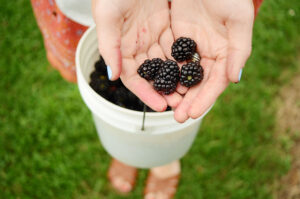
Bramble growers can capitalize on marketing the health benefits of blackberries and raspberries to consumers. Photo: Luke Freeman, NCAT
Marketing Health through Bramble Fruits
The demand for nutritionally enhanced foods continues to grow. Beyond their vitamin and mineral content, bramble fruits are now known to contain important phytochemicals (naturally occurring compounds). The term nutraceutical refers to a phytochemical substance that may be considered food (or part of a food) and that provides medical or health benefits, such as prevention and treatment of disease. Nutraceuticals represent one of the most important food-industry trends for marketing to an increasingly knowledgeable and health-conscious consumer. Information on nutraceutical properties of bramble fruits can be found here.
Value-Added Products
Not all harvested berries will be suitable for the fresh market, due to blemishes or physical damage, but these berries can still be used to create products that will bring in farm revenue. Value-added products such as jams and jellies can be made using culled berries and surplus berries, to maximize the income from your harvested crop. For small-scale growers, there are cottage food laws in most states that allow for the use of the home kitchen to produce jams and jellies for sale. Because regulations differ from state to state, it is important to familiarize yourself with the cottage food laws in your own state before starting a value-added enterprise. For more information on value-added farm products, see the ATTRA publication Adding Value to Farm Products: An Overview.
Brambles: Organic Production
By George L. Kuepper, Holly Born, Janet Bachmann
NCAT Agriculture specialists
Published January 2003
Updated March 2017
By Luke Freeman, NCAT Agriculture Specialist
©NCAT
IP022
Mention of specific products, companies, or manufacturers is for educational purposes only and does not constitute endorsement by NCAT, ATTRA, or USDA.
This publication is produced by the National Center for Appropriate Technology through the ATTRA Sustainable Agriculture program, under a cooperative agreement with USDA Rural Development. ATTRA.NCAT.ORG
Related Publications
- Climate Change and Perennial Fruit and Nut Production: Investing in Resilience in Uncertain Times
- Fruit Trees, Bushes, and Vines for Natural Growing in the Ozarks
- High Tunnel Tree Fruit and Grape Production for Eastern Growers
- Tree Fruits: Organic Production Overview
- Adding Value to Farm Products: An Overview
- A Pictorial Guide to Hedegrow Plants for Beneficial Insects
- Organic IPM Field Guide
- Overview of Cover Crops and Green Manures
- Soils and Sites for Organic Orchards and Vineyards


